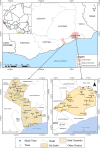Stage-specific Plasmodium falciparum immune responses in afebrile adults and children living in the Greater Accra Region of Ghana
- PMID: 32041620
- PMCID: PMC7011432
- DOI: 10.1186/s12936-020-3146-7
Stage-specific Plasmodium falciparum immune responses in afebrile adults and children living in the Greater Accra Region of Ghana
Abstract
Background: Asymptomatic carriage of Plasmodium falciparum is widespread in adults and children living in malaria-endemic countries. This study identified the prevalence of malaria parasites and the corresponding levels of naturally acquired anti-parasite antibody levels in afebrile adults living in two communities in the Greater Accra Region of Ghana.
Methods: Two cross-sectional studies conducted in January and February 2016 and repeated in July and August 2016 recruited subjects aged between 6 and 75 years from high parasite prevalence (Obom) and low parasite prevalence (Asutsuare) communities. Whole blood (5 ml) was collected from each volunteer, plasma was aliquoted and frozen until needed. An aliquot (10 µl) of the blood was used to prepare thick and thin blood smears, 100 µl was preserved in Trizol and the rest was separated into plasma and blood cells and each stored at - 20 °C until needed. Anti-MSP3 and Pfs230 antibody levels were measured using ELISA.
Results: Asexual parasite and gametocyte prevalence were higher in Obom than Asutsuare. Antibody (IgG, IgG1, IgG3, IgM) responses against the asexual parasite antigen MSP3 and gametocyte antigen Pfs230 were higher in Obom during the course of the study except for IgM responses against Pfs230, which was higher in Asutsuare than in Obom during the rainy season. Antibody responses in Asutsuare were more significantly associated with age than the responses measured in Obom.
Conclusion: The pattern of antibody responses measured in people living in the high and low malaria transmission setting was similar. All antibody responses measured against the asexual antigen MSP3 increased, however, IgG and IgG1 responses against gametocyte antigen Pfs230 decreased in moving from the dry to the peak season in both sites. Whilst asexual and gametocyte prevalence was similar between the seasons in the low transmission setting, in the high transmission setting asexual parasite prevalence increased but gametocyte prevalence decreased in the rainy season relative to the dry season.
Keywords: Afebrile; Antibody; Gametocyte; Transmission.
Conflict of interest statement
The authors declare that they have no competing interests.
Figures



Similar articles
-
Malaria elimination in Ghana: recommendations for reactive case detection strategy implementation in a low endemic area of Asutsuare, Ghana.Malar J. 2024 Jan 2;23(1):5. doi: 10.1186/s12936-023-04792-z. Malar J. 2024. PMID: 38167067 Free PMC article. Review.
-
The prevalence of submicroscopic Plasmodium falciparum gametocyte carriage and multiplicity of infection in children, pregnant women and adults in a low malaria transmission area in Southern Ghana.Malar J. 2018 Sep 17;17(1):331. doi: 10.1186/s12936-018-2479-y. Malar J. 2018. PMID: 30223841 Free PMC article.
-
Dynamics of anti-MSP3 and Pfs230 antibody responses and multiplicity of infection in asymptomatic children from southern Ghana.Parasit Vectors. 2018 Jan 5;11(1):13. doi: 10.1186/s13071-017-2607-5. Parasit Vectors. 2018. PMID: 29304870 Free PMC article.
-
Diversity and immune responses against Plasmodium falciparum gametocytes in non-febrile school children living in Southern Ghana.Malar J. 2019 Aug 1;18(1):265. doi: 10.1186/s12936-019-2895-7. Malar J. 2019. PMID: 31370841 Free PMC article.
-
Immune Responses to Gametocyte Antigens in a Malaria Endemic Population-The African falciparum Context: A Systematic Review and Meta-Analysis.Front Immunol. 2019 Oct 22;10:2480. doi: 10.3389/fimmu.2019.02480. eCollection 2019. Front Immunol. 2019. PMID: 31695697 Free PMC article.
Cited by
-
Diagnostic performance of an ultra-sensitive RDT and a conventional RDT in malaria mass testing, treatment and tracking interventions in southern Ghana.Parasit Vectors. 2024 Jul 1;17(1):280. doi: 10.1186/s13071-024-06354-x. Parasit Vectors. 2024. PMID: 38951912 Free PMC article.
-
Malaria elimination in Ghana: recommendations for reactive case detection strategy implementation in a low endemic area of Asutsuare, Ghana.Malar J. 2024 Jan 2;23(1):5. doi: 10.1186/s12936-023-04792-z. Malar J. 2024. PMID: 38167067 Free PMC article. Review.
-
Persistent Plasmodium falciparum infections enhance transmission-reducing immunity development.Sci Rep. 2021 Nov 1;11(1):21380. doi: 10.1038/s41598-021-00973-5. Sci Rep. 2021. PMID: 34725428 Free PMC article.
-
Detecting asymptomatic carriage of Plasmodium falciparum in southern Ghana: utility of molecular and serological diagnostic tools.Malar J. 2022 Feb 19;21(1):57. doi: 10.1186/s12936-022-04078-w. Malar J. 2022. PMID: 35183178 Free PMC article.
-
A Molecular Analysis of Memory B Cell and Antibody Responses Against Plasmodium falciparum Merozoite Surface Protein 1 in Children and Adults From Uganda.Front Immunol. 2022 Jun 2;13:809264. doi: 10.3389/fimmu.2022.809264. eCollection 2022. Front Immunol. 2022. PMID: 35720313 Free PMC article.
References
-
- Nebie I, Diarra A, Ouedraogo A, Soulama I, Bougouma EC, Tiono AB, et al. Humoral responses to Plasmodium falciparum blood-stage antigens and association with incidence of clinical malaria in children living in an area of seasonal malaria transmission in Burkina Faso, West Africa. Infect Immun. 2008;76:759–766. doi: 10.1128/IAI.01147-07. - DOI - PMC - PubMed
MeSH terms
Substances
Grants and funding
LinkOut - more resources
Full Text Sources

